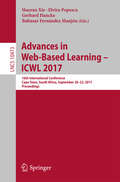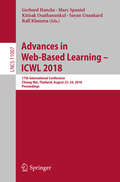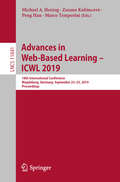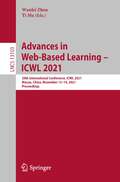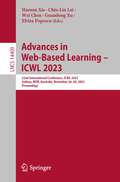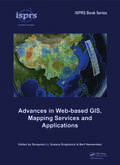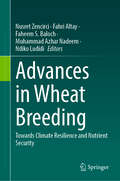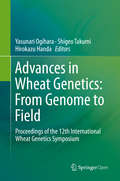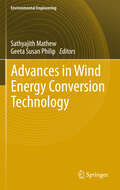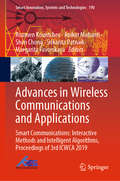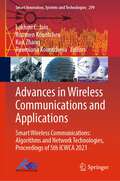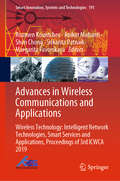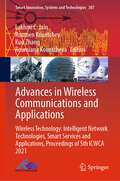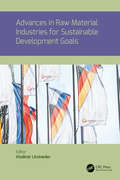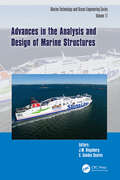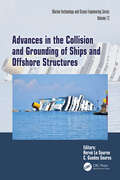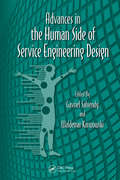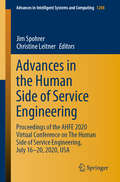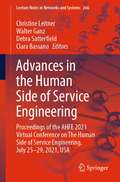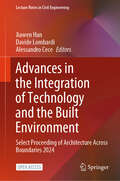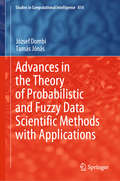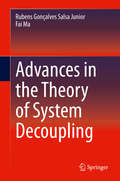- Table View
- List View
Advances in Web-Based Learning – ICWL 2017: 16th International Conference, Cape Town, South Africa, September 20-22, 2017, Proceedings (Lecture Notes in Computer Science #10473)
by Baltasar Fernández Manjón Elvira Popescu Haoran Xie Gerhard HanckeThis book constitutes the proceedings of the 16th International Conference on Web-Based Learning, ICWL 2017, held in Cape Town, South Africa, in September 2017. The 13 revised full papers presented together with 9 short papers and 3 poster papers were carefully reviewed and selected from 56 submissions. The papers are organized in topical sections on Inquiry-Based Learning and Gamification; Learning Analytics; Social Media and Web 2. 0-based Learning Environments; Assessment and Accessibility in Higher Education; Open Educational Resources and Recommender Systems; and Practice and Experience Sharing.
Advances in Web-Based Learning – ICWL 2018: 17th International Conference, Chiang Mai, Thailand, August 22-24, 2018, Proceedings (Lecture Notes in Computer Science #11007)
by Ralf Klamma Marc Spaniol Gerhard Hancke Kitisak Osathanunkul Sayan UnankardThis book constitutes the proceedings of the 17th International Conference on Web-Based Learning, ICWL 2018, held in Chiang Mai, Thailand, in August 2018.The 11 revised full papers presented together with 4 short papers were carefully reviewed and selected from 37 submissions. The papers are organized in topical sections on learning assessment and behavior; case studies; augmented reality and collaborative learning; game-based learning; and learning content management and experience sharing.
Advances in Web-Based Learning – ICWL 2019: 18th International Conference, Magdeburg, Germany, September 23–25, 2019, Proceedings (Lecture Notes in Computer Science #11841)
by Marco Temperini Michael A. Herzog Zuzana Kubincová Peng HanThis book constitutes the proceedings of the 18th International Conference on Advances in Web-Based Learning, ICWL 2019, held in Magdeburg, Germany, in September 2019. The 15 full, 15 short, and 7 poster papers presented in this volume were carefully reviewed and selected from 68 submissions. The contributions were organized in topical sections named: Semantic Web for E-Learning, Learning Analytics, Computer Supported Collaborative Learning, Assessment and Pedagogical Issues, E-learning Platforms and Tools, Mobile Learning, and Poster Papers.
Advances in Web-Based Learning – ICWL 2021: 20th International Conference, ICWL 2021, Macau, China, November 13–14, 2021, Proceedings (Lecture Notes in Computer Science #13103)
by Wanlei Zhou Yi MuThis book constitutes the proceedings of the 20th International Conference on Advances in Web-Based Learning, ICWL 2021, which was held in Macau, China, in November 2021. The papers included in this volume deal with multiple topics, from algorithms to systems and applications and are organized in 3 tracks: Online learning methodologies, trust, and analysis; Online learning environment with tools; Online learning privacy issues and special tools.
Advances in Web-Based Learning – ICWL 2023: 22nd International Conference, ICWL 2023, Sydney, NSW, Australia, November 26–28, 2023, Proceedings (Lecture Notes in Computer Science #14409)
by Wei Chen Guandong Xu Elvira Popescu Haoran Xie Chiu-Lin LaiThis book constitutes the proceedings of the International Conference on Web-Based Learning, ICWL 2023, in Sydney, NSW, Australia, in November 2023.The 9 full papers together with 7 short papers included in this volume were carefully reviewed and selected from 23 submissions. The conference focuses on subjects such as Semantic Web for E-Learning, through Learning Analytics, Computer-Supported Collaborative Learning, Assessment, Pedagogical Issues, E-learning Platforms, and Tools, to Mobile Learning.
Advances in Web-based GIS, Mapping Services and Applications (ISSN)
by Songnian Li Suzana Dragićević Bert VeenendaalAdvances in Web-based GIS, Mapping Services and Applications is published as part of ISPRS WG IV/5 effort, and aims at presenting (1) Recent technological advancements, e.g., new developments under Web 2.0, map mashups, neogeography and the like; (2) Balanced theoretical discussions and technical implementations; (3) Commentary on the current stage
Advances in Welding Technologies for Process Development
by Jaykumar Vora Vishvesh J. BadhekaWithin manufacturing, welding is by far the most widely used fabrication method used for production, leading to a rise in research and development activities pertaining to the welding and joining of different, similar, and dissimilar combinations of the metals. This book addresses recent advances in various welding processes across the domain, including arc welding and solid-state welding process, as well as experimental processes. The content is structured to update readers about the working principle, predicaments in existing process, innovations to overcome these problems, and direct industrial and practical applications. Key Features: Describes recent developments in welding technology, engineering, and science Discusses advanced computational techniques for procedure development Reviews recent trends of implementing DOE and meta-heuristics optimization techniques for setting accurate parameters Addresses related theoretical, practical, and industrial aspects Includes all the aspects of welding, such as arc welding, solid state welding, and weld overlay
Advances in Wheat Breeding: Towards Climate Resilience and Nutrient Security
by Nusret Zencirci Faheem S. Baloch Fahri Altay Muhammad Azhar Nadeem Ndiko LudidiThis edited book addresses the introduction to wheat, advancements in breeding, the contribution of biotechnological approaches, the development of climate-resilient wheat cultivars, and biofortification efforts to create nutrient-rich wheat cultivars.The world faces simultaneous challenges of a growing population and climate change. It is anticipated that the world population will exceed 9 billion by 2050. Meanwhile, climate change significantly impacts agriculture through uneven patterns, expected to worsen in the coming years, resulting in substantial losses due to biotic and abiotic stresses. Wheat, a staple food for millions worldwide, requires more studies to develop climate-resilient cultivars with improved nutritional content. Given these considerations, it is crucial to understand the activities conducted for wheat breeding and address the current gap to ensure an ample food supply for future generations.This book is beneficial for researchers, teachers, agriculturists, biologists, climate change scientists, and organizations involved in wheat breeding. It also serves as a valuable resource for undergraduate, master, and PhD students interested in wheat.
Advances in Wheat Genetics: Proceedings of the 12th International Wheat Genetics Symposium
by Yasunari Ogihara Shigeo Takumi Hirokazu HandaThis proceedings is a collection of 46 selected papers that were presented at the 12th International Wheat Genetics Symposium (IWGS). Since the launch of the wheat genome sequencing project in 2005, the arrival of draft genome sequences has marked a new era in wheat genetics and genomics, catalyzing rapid advancement in the field. This book provides a comprehensive review of the forefront of wheat research, across various important topics such as germplasm and genetic diversity, cytogenetics and allopolyploid evolution, genome sequencing, structural and functional genomics, gene function and molecular biology, biotic stress, abiotic stress, grain quality, and classical and molecular breeding. Following an introduction, 9 parts of the book are dedicated to each of these topics. A final, 11th part entitled "Toward Sustainable Wheat Production" contains 7 excellent papers that were presented in the 12th IWGS Special Session supported by the OECD. With rapid population growth and radical climate changes, the world faces a global food crisis and is in need of another Green Revolution to boost yields of wheat and other widely grown staple crops. Although this book focuses on wheat, many of the newly developed techniques and results presented here can be applied to other plant species with large and complex genomes. As such, this volume is highly recommended for all students and researchers in wheat sciences and related plant sciences and for those who are interested in stable food production and food security.
Advances in Wind Energy Conversion Technology (Environmental Science and Engineering)
by Geeta Susan Philip Mathew SathyajithWith an annual growth rate of over 35%, wind is the fastest growing energy source in the world today. As a result of intensive research and developmental efforts, the technology of generating energy from wind has significantly changed during the past five years. The book brings together all the latest aspects of wind energy conversion technology - right from the wind resource analysis to grid integration of the wind generated electricity. The chapters are contributed by academic and industrial experts having vast experience in these areas. Each chapter begins with an introduction explaining the current status of the technology and proceeds further to the advanced lever to cater for the needs of readers from different subject backgrounds. Extensive bibliography/references appended to each chapter give further guidance to the interested readers.
Advances in Wireless Communications and Applications: Smart Communications: Interactive Methods and Intelligent Algorithms, Proceedings of 3rd ICWCA 2019 (Smart Innovation, Systems and Technologies #190)
by Srikanta Patnaik Margarita Favorskaya Roumen Kountchev Aniket Mahanti Shen ChongThis book features selected papers presented at the 3rd International Conference on Wireless Communications and Applications (ICWCA 2019), held at Hainan University, China. Focusing on applications of the latest smart theories and approaches, and recent advances in the field, it covers topics such as OFDM and multi-carrier techniques; smart antenna and space-time signal processing; MIMO, multi-user MIMO, and massive MIMO; modulation, coding, and diversity techniques; dynamic spectrum access and cognitive radio; interference management and radio resource allocation; equalization techniques; synchronization, estimation, and detection techniques; and wireless multiple access (e.g. CDMA, OFDMA, NOMA, ).
Advances in Wireless Communications and Applications: Smart Wireless Communications: Algorithms and Network Technologies, Proceedings of 5th ICWCA 2021 (Smart Innovation, Systems and Technologies #299)
by Lakhmi C. Jain Roumen Kountchev Kun Zhang Roumiana KountchevaThis book features selected papers presented at the 5th International Conference on Wireless Communications and Applications (ICWCA 2021), held at Hainan University, China. The book will focus on the presentation of the newest trends and achievements in the development of intelligent algorithms and network technologies in smart communications, with application in underwater communications, IoT-based marine surface communications as well as state-of-the-art real-time precise location technologies, Wi-Fi/Bluetooth locationing, array signal processing, and many others.
Advances in Wireless Communications and Applications: Wireless Technology: Intelligent Network Technologies, Smart Services and Applications, Proceedings of 3rd ICWCA 2019 (Smart Innovation, Systems and Technologies #191)
by Srikanta Patnaik Margarita Favorskaya Roumen Kountchev Aniket Mahanti Shen ChongThis book gathers selected papers presented at the 3rd International Conference on Wireless Communications and Applications (ICWCA 2019), held at Hainan University, China. It covers up-to-date smart theories and approaches, as reflected in contemporary technical achievements in the area. The topics covered include: software-defined networking (SDN) and network function virtualization (NFV), future data center networks, 5G/6G mobile networks, QoS/QoE support in future networks, future Internet of things (IoT) networks, network fault management and service availability, and many others.
Advances in Wireless Communications and Applications: Wireless Technology: Intelligent Network Technologies, Smart Services and Applications, Proceedings of 5th ICWCA 2021 (Smart Innovation, Systems and Technologies #307)
by Lakhmi C. Jain Roumen Kountchev Kun Zhang Roumiana KountchevaThis book features selected papers presented at the 5th International Conference on Wireless Communications and Applications (ICWCA 2021), held at Hainan University, China. The book will focus on the presentation of the newest trends and achievements in the development of intelligent algorithms and network technologies in smart communications, with application in underwater communications, IoT-based marine surface communications as well as state-of-the-art real-time precise location technologies, WiFi/Bluetooth locationing, array signal processing and many others.
Advances in Wireless Sensor Networks: The 8th China Conference, CWSN 2014, Xi'an, China, October 31--November 2, 2014. Revised Selected Papers (Communications in Computer and Information Science #501)
by Wei Wang Limin Sun Huadong Ma Dingyi Fang Jinping NiuThis book constitutes the refereed proceedings of the 8th China Conference of Wireless Sensor Networks, held in Xi'an, China, in October/November 2014. The 64 revised full papers were carefully reviewed and selected from 365 submissions. The papers are organized in topical sections on power control and management; network architecture and deployment; positioning and location-based services in wireless sensor networks; security and privacy; wireless communication systems and protocols; routing algorithm and transport protocols in wireless sensor networks; wireless communication protocols and sensor data quality, integrity and trustworthiness; Internet of Things; wireless mobile network architecture, in-vehicle network; indoor positioning and location-based services; applications of wireless sensor networks.
Advances in raw material industries for sustainable development goals: PROCEEDINGS OF THE XII RUSSIAN-GERMAN RAW MATERIALS CONFERENCE (SAINT-PETERSBURG, RUSSIA, 27-29 NOVEMBER 2019)
by Vladimir Litvinenko"Advances in Raw Material Industries for Sustainable Development Goals" presents the results of joint scientific research conducted in the context of the Russian-German Raw Materials Forum. Today Russia and Germany are exploring various forms of cooperation in the field of mining, geology, mineralogy, mechanical engineering and energy. Russia and Germany are equally interested in expanding cooperation and modernizing the economy in terms of sustainable development. The main theme of this article collection is connected with existing business ventures and ideas from both Russia and Germany. In this book the authors regard complex processes in mining industry from various points of view, including: - modern technologies in prospecting, exploration and development of mineral resources- progressive methods of natural and industrial mineral raw materials processing- energy technologies and digital technologies for sustainable development- cutting-edge technologies and innovations in the oil and gas industry. Working with young researchers, supporting their individual professional development and creating conditions for their mobility and scientific cooperation are essential parts of Russian-German Raw Materials Forum founded in Dresden 13 years ago. This collection represents both willingness of young researchers to be involved in large-scale international projects like Russian-German Raw Material Forum and the results of their long and thorough work in the promising areas of cooperation between Russia and Germany.
Advances in the Analysis and Design of Marine Structures: Proceedings of the 9th International Conference on Marine Structures (MARSTRUCT 2023, Gothenburg, Sweden, 3-5 April 2023) (Proceedings in Marine Technology and Ocean Engineering)
by J. W. RingsbergAdvances in the Analysis and Design of Marine Structures is a collection of papers presented at MARSTRUCT 2023, the 9th International Conference on Marine Structures, held in Gothenburg, Sweden, 3-5 April 2023. The conference was organised by the Division of Marine Technology, Department of Mechanics and Maritime Sciences at Chalmers University of Technology, in Gothenburg, Sweden. The MARSTRUCT Conference series deals with Ship and Offshore Structures, addressing topics in the fields of: • Methods and tools for loads and load effects• Methods and tools for strength assessment• Experimental analysis of structures• Materials and fabrication of structures• Methods and tools for structural design and optimization• Structural reliability, safety, and environmental protection The MARSTRUCT conferences series of started in Glasgow, UK in 2007, the second event of the series took place in Lisbon, Portugal in March 2009, the third in Hamburg, Germany in March 2011, the fourth in Espoo, Finland in March 2013, the fifth in Southampton, UK in March 2015, the sixth in Lisbon, Portugal in May 2017, the seventh in Dubrovnik, Croatia in May 2019, and the eighth event in Trondheim, Norway in June 2021. Advances in the Analysis and Design of Marine Structures is essential reading for academics, engineers and all professionals involved in the design of marine and offshore structures. The Proceedings in Marine Technology and Ocean Engineering series is devoted to the publication of proceedings of peer-reviewed international conferences dealing with various aspects of ‘Marine Technology and Ocean Engineering’. The Series includes the proceedings of the following conferences: the International Maritime Association of the Mediterranean (IMAM) Conferences, the Marine Structures (MARSTRUCT) Conferences, the Renewable Energies Offshore (RENEW) Conferences and the Maritime Technology (MARTECH) Conferences. The ‘Marine Technology and Ocean Engineering’ series is also open to new conferences that cover topics on the sustainable exploration and exploitation of marine resources in various fields, such as maritime transport and ports, usage of the ocean including coastal areas, nautical activities, the exploration and exploitation of mineral resources, the protection of the marine environment and its resources, and risk analysis, safety and reliability. The aim of the series is to stimulate advanced education and training through the wide dissemination of the results of scientific research.
Advances in the Collision and Grounding of Ships and Offshore Structures: PROCEEDINGS OF THE 9th INTERNATIONAL CONFERENCE ON COLLISION AND GROUNDING OF SHIPS AND OFFSHORE STRUCTURES (ICCGS 2023), NANTES, FRANCE, 11-13 SEPTEMBER 2023 (Proceedings in Marine Technology and Ocean Engineering)
by H. Le SourneThis book offers state-of-the-art developments in the collision and grounding of ship and offshore structures. The topics covered by the contributions include: dynamics of vessels in collision and grounding; collision and grounding in Arctic conditions; collision and grounding statistics and measures of the probability of incidents; risk assessment of collision and grounding; measures for reduction of collision and grounding, machine learning methods for the evaluation of probabilistic collision and grounding risk; new designs for improvement of structural resistance to collisions; analysis of ultimate strength of damaged ship structures; design of buffer bows to reduce collision consequences; innovative navigation systems for safer sea transportation, collision between ships and offshore structures; collision between ships and fixed or floating bridges, collision and grounding experiments; properties of materials under impact loadings; residual strength of damaged ships and offshore structures; hull girder response of ships under severe dynamic loadings. The book is aimed at naval architects, marine engineers and scientists. The ICCGS conferences aim to present state-of-the-art methods for analysis and design against collision and grounding of ships, collisions between ships and icebergs, offshore structures, bridges, submerged tunnels and waterfront structures. Previous conferences were held in: San Francisco, USA in 1996; Copenhagen, Denmark in 2001; Tokyo, Japan in 2004; Hamburg, Germany in 2007; Helsinki, Finland in 2010; Trondheim, Norway in 2013; Ulsan, South Korea in 2016, and Lisbon, Portugal in 2019. The Proceedings in Marine Technology and Ocean Engineering series is devoted to the publication of proceedings of peer-reviewed international conferences dealing with various aspects of ‘Marine Technology and Ocean Engineering’. The Series includes the proceedings of the following conferences: the International Maritime Association of the Mediterranean (IMAM) Conferences, the Marine Structures (MARSTRUCT) Conferences, the Renewable Energies Offshore (RENEW) Conferences and the Maritime Technology (MARTECH) Conferences, and the Collision and Grounding of Ships and Offshore Structures (ICCGS) conferences. The ‘Marine Technology and Ocean Engineering’ series is also open to new conferences that cover topics on the sustainable exploration and exploitation of marine resources in various fields, such as maritime transport and ports, usage of the ocean including coastal areas, nautical activities, the exploration and exploitation of mineral resources, the protection of the marine environment and its resources, and risk analysis, safety and reliability. The aim of the series is to stimulate advanced education and training through the wide dissemination of the results of scientific research.
Advances in the Diagnosis and Treatment of Sleep Apnea: Filling the Gap Between Physicians and Engineers (Advances in Experimental Medicine and Biology #1384)
by Thomas Penzel Roberto HorneroThe book focuses on biomedical innovations related to the diagnosis and treatment of sleep apnea. The latest diagnostic tools are described, including sleep laboratory equipment, wearables, and even smartphone apps. Innovative medical devices for treatment are also covered, such as CPAP, Auto-PAP, hypoglossal nerve stimulation, phrenic nerve stimulation, acoustic brain stimulation and electrical brain stimulation. This is an ideal book for biomedical engineers, pneumologists, neurologists, cardiologists, physiologists, ENT physicians, pediatrics, and epidemiologists who are interested in learning about the latest technologies in treating and diagnosing sleep apnea.
Advances in the Human Side of Service Engineering
by James C. Spohrer Louis E. FreundIf there is any one element to the engineering of service systems that is unique, it is the extent to which the suitability of the system for human use, human service, and excellent human experience has been and must always be considered. An exploration of this emerging area of research and practice, Advances in the Human Side of Service Engineerin
Advances in the Human Side of Service Engineering: Proceedings of the AHFE 2020 Virtual Conference on The Human Side of Service Engineering, July 16-20, 2020, USA (Advances in Intelligent Systems and Computing #1208)
by Jim Spohrer Christine LeitnerThis book reports on cutting-edge research and best practices in developing innovative service systems. It covers issues concerning the suitability of a given system for human use, human services, and excellent human experiences. It explores a wide range of ways in which human factors in engineering, ergonomics, human–computer interaction (HCI), cognitive engineering, and many other disciplines can contribute to the design and management of service systems. It considers aspects related to cost effectiveness, ethics, and privacy, among others, and covers applications in many areas, from healthcare to education, transportation, and the economy. Based on the AHFE 2020 Virtual Conference on the Human Side of Service Engineering, held on July 16–20, 2020, the book provides readers with a comprehensive overview of current research and future challenges in the field of service engineering, together with practical insights into the development of innovative services for various kinds of organizations.
Advances in the Human Side of Service Engineering: Proceedings of the AHFE 2021 Virtual Conference on The Human Side of Service Engineering, July 25-29, 2021, USA (Lecture Notes in Networks and Systems #266)
by Walter Ganz Clara Bassano Christine Leitner Debra SatterfieldThis book reports on cutting-edge research and best practices in developing innovative service systems. It covers issues concerning the suitability of a given system for human use, human services, and excellent human experiences. It explores a wide range of ways in which human factors in engineering, ergonomics, human–computer interaction (HCI), cognitive engineering, and many other disciplines can contribute to the design and management of service systems. It considers aspects related to cost effectiveness, ethics, and privacy, among others, and covers applications in many areas, from healthcare to education, transportation, and the economy. Based on the AHFE 2021 Conference on the Human Side of Service Engineering, held virtually on 25–29 July, 2021, from USA, this book provides readers with a comprehensive overview of current research and future challenges in the field of service engineering, together with practical insights into the development of innovative services for various kinds of organizations.
Advances in the Integration of Technology and the Built Environment: Select Proceeding of Architecture Across Boundaries 2024 (Lecture Notes in Civil Engineering #593)
by Jiawen Han Davide Lombardi Alessandro CeceThis open access book will be a compilation of selected papers from the 2nd International Conference on Architecture Across Boundaries (AAB2024). The work focuses on novel integration of technology into the built environment in the areas of space syntax, digital fabrication, computational design, professional models, eco-system and urban morphology domains. The content makes valuable contributions to academic researchers and educators in the university and practitioners in the industry, who have been working in or with a particular awareness of the different types of boundaries, including technological, cultural and physical boundaries in the research on built environments. This book will work as a good reference for academics and professionals conducting interdisciplinary research in an effort to understand and achieve a better hybrid environment.
Advances in the Theory of Probabilistic and Fuzzy Data Scientific Methods with Applications (Studies in Computational Intelligence #814)
by József Dombi Tamás JónásThis book focuses on the advanced soft computational and probabilistic methods that the authors have published over the past few years. It describes theoretical results and applications, and discusses how various uncertainty measures – probability, plausibility and belief measures – can be treated in a unified way. It also examines approximations of four notable probability distributions (Weibull, exponential, logistic and normal) using a unified probability distribution function, and presents a fuzzy arithmetic-based time series model that provides an easy-to-use forecasting technique. Lastly, it proposes flexible fuzzy numbers for Likert scale-based evaluations. Featuring methods that can be successfully applied in a variety of areas, including engineering, economics, biology and the medical sciences, the book offers useful guidelines for practitioners and researchers.
Advances in the Theory of System Decoupling
by Rubens Gonçalves Salsa Junior Fai MaThis book presents a concise, clear, and consistent account of the methodology of phase synchronization, an extension of modal analysis to decouple any linear system in real space. It expounds on the novel theory of phase synchronization and presents recent advances, while also providing relevant background on classical decoupling theories that are used in structural analysis. The theory is illustrated with a broad range of examples. The theoretical development is also supplemented by applications to engineering problems. In addition, the methodology is implemented in a MATLAB algorithm which can be used to solve many of the illustrative examples in the book. This book is suited for researchers, practicing engineers, and graduate students in various fields of engineering, mathematics, and physical science.
